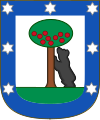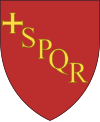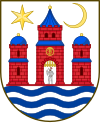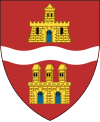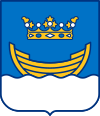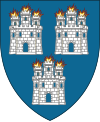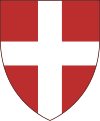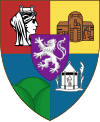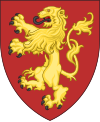Portal:European Union/Cities
Cities 1
Portal:European Union/Cities/1
Berlin is the capital city and one of 16 states of Germany. With a population of 3.4 million people, Berlin is Germany's largest city. It is the second most populous city proper in the European Union. Located in northeastern Germany, it is the center of the Berlin-Brandenburg Metropolitan Area, comprising 5 million people from over 190 nations. Geographically embedded in the European Plains, Berlin is influenced by a temperate seasonal climate. Around one third of the city's territory is composed of forests, parks, gardens, rivers and lakes.
First documented in the 13th century, Berlin was successively the capital of the Kingdom of Prussia (1701–1918), the German Empire (1871–1918), the Weimar Republic (1919–1933) and the Third Reich (1933–1945). During the 1920s, Berlin was the third largest municipality in the world. After World War II, the city was divided; East Berlin became the capital of East Germany while West Berlin became a de facto West German exclave, surrounded by the Berlin Wall (1961–1989). Following German reunification in 1990, the city regained its status as the capital of all Germany hosting 147 foreign embassies.
Berlin is a world city of culture, politics, media, and science. Its economy is primarily based on the service sector, encompassing a diverse range of creative industries, media corporations, congress and convention venues. Berlin serves as a continental hub for air and rail transport, and is one of the most visited tourist destinations in the EU. Significant industries include IT, pharmaceuticals, biomedical engineering, biotechnology, optoelectronics, traffic engineering, and renewable energy.
The metropolis is home to renowned universities, research institutes, sporting events, orchestras, museums and personalities. The urban and historical legacy has made it a popular setting for international film productions. The city is recognized for its festivals, diverse architecture, nightlife, contemporary arts, public transportation networks and a high quality of living.
Berlin has evolved into a global focal point for young individuals and artists attracted by a liberal lifestyle and modern zeitgeist.
Cities 2
Portal:European Union/Cities/2
Berlin is the capital city and one of 16 states of Germany. With a population of 3.4 million people, Berlin is Germany's largest city. It is the second most populous city proper in the European Union. Located in northeastern Germany, it is the center of the Berlin-Brandenburg Metropolitan Area, comprising 5 million people from over 190 nations. Geographically embedded in the European Plains, Berlin is influenced by a temperate seasonal climate. Around one third of the city's territory is composed of forests, parks, gardens, rivers and lakes.
First documented in the 13th century, Berlin was successively the capital of the Kingdom of Prussia (1701–1918), the German Empire (1871–1918), the Weimar Republic (1919–1933) and the Third Reich (1933–1945). During the 1920s, Berlin was the third largest municipality in the world. After World War II, the city was divided; East Berlin became the capital of East Germany while West Berlin became a de facto West German exclave, surrounded by the Berlin Wall (1961–1989). Following German reunification in 1990, the city regained its status as the capital of all Germany hosting 147 foreign embassies.
Berlin is a world city of culture, politics, media, and science. Its economy is primarily based on the service sector, encompassing a diverse range of creative industries, media corporations, congress and convention venues. Berlin serves as a continental hub for air and rail transport, and is one of the most visited tourist destinations in the EU. Significant industries include IT, pharmaceuticals, biomedical engineering, biotechnology, optoelectronics, traffic engineering, and renewable energy.
The metropolis is home to renowned universities, research institutes, sporting events, orchestras, museums and personalities. The urban and historical legacy has made it a popular setting for international film productions. The city is recognized for its festivals, diverse architecture, nightlife, contemporary arts, public transportation networks and a high quality of living.
Berlin has evolved into a global focal point for young individuals and artists attracted by a liberal lifestyle and modern zeitgeist.
Cities 3
Portal:European Union/Cities/3
Madrid is the capital of Spain, and the largest city in Spain. It is located on the river Manzanares in the center of the country, between the Autonomous Communities of Castilla y Leon and Castilla la Mancha. Madrid is also the capital of the Community of Madrid, an uniprovincial Autonomous Community. Due to its geographical location, wealth and history, Madrid is considered one of the financial centers of the Iberian Peninsula, together with Lisbon, and the political center of Spain.
As the capital of the former Spanish Empire, Madrid is a city of great cultural and political importance. While Madrid possesses a modern infrastructure, it has preserved the look and feel of many of its historic neighborhoods and streets. Its landmarks include the huge Royal Palace of Madrid; the Buen Retiro park, opened in 1631; an archaeological museum of international reputation; and three superb art museums.
Cities 4
Portal:European Union/Cities/4
Rome is the capital of Italy and of its region, called Lazio. It is located across the confluence of the Tiber and Aniene rivers. It was once the capital of the Roman Empire, the most powerful, largest and longest lasting empire of classical Western civilization. The Vatican, a sovereign enclave within Rome, is the seat of the Roman Catholic Church and the home of the Pope.
Rome is the largest comune in Italy and it is also one of the largest European capital cities in land area, with an area of 1,285 square kilometers. Within the city limits, the population is about 2.5 million; almost 3.8 million live in the urbanised area of Rome, as represented by the province of Rome, making it second in population to Milan. With a gross domestic product of €97 billion in the year 2005, Rome produced 6.7% of Italy's GDP.
Cities 5
Portal:European Union/Cities/5
Paris is the capital city of France. Situated on the banks of the river Seine in north-central France, it is also the capital of the Île-de-France région, which encompasses Paris and its suburbs. The City of Paris had an estimated mid-2004 population of 2,144,700. The Paris urban area, extending well beyond the city boundaries, has today an estimated population of 9.9 million. The Paris metropolitan area (including satellite towns) stood at 11.5 million in 1999.
It produces more than a quarter of France's wealth, with a GDP of €478.7 billion in 2005. With La Défense, one of the largest business districts in Europe, Paris also hosts the head offices of almost half of the major French companies. Paris is a leading global cultural, business and political centre and has a major international influence in fashion, gastronomy and the arts. It is widely regarded as one of the world's major global cities, with notably the headquarters of many international organisations such as UNESCO, the OECD, the ICC.
Cities 6
Portal:European Union/Cities/6
Amsterdam, capital city of the Netherlands, lies on the banks of two bodies of water, the IJ bay and the Amstel river. Founded in the late 12th century as a small fishing village on the banks of the Amstel, it is now the largest city in the country and is a financial and cultural centre. In 2006, the population of the municipality proper was 741,329; the population of the official Greater Amsterdam area is approximately 1.5 million, but the real agglomeration is estimated at 2 to 2.5 million. Amsterdam is also one of the core urban centres of the greater metropolitan area called Randstad (English: "Ring City") which encompasses other Dutch cities and has a population of over 7.5 million.
Amsterdam has one of the largest historic city centres in Europe, dating largely from the 17th century. At this time, a series of concentric, semi-circular canals (grachten) were dug around the old city centre. Along the canals houses and warehouses were built. The canals still define Amsterdam's layout and appearance today. Amsterdam is famous for its free-spirited liberalism, diversity and tolerance.
Cities 7
Portal:European Union/Cities/7
Athens is the capital and largest city of Greece. Named after goddess Athena, Athens is a cosmopolitan metropolis with a population of 3.7 million people. The Athens metropolitan area constitutes the center of economic, financial, industrial, cultural and political life in Greece. The city is also rapidly becoming a business center in the European Union.
Ancient Athens was a powerful polis city-state and a renowned center of learning, home of Plato's Academy and Aristotle's Lyceum. It is often referred to as the cradle of Western civilization, largely due to the impact of its cultural and political achievements during the 5th and 4th centuries BCE on the rest of the then known European Continent. The classical era heritage is still evident in the city, portrayed through a number of ancient monuments and artworks, the most famous being the Parthenon on the Acropolis. Athens was the host city of the first modern-day Olympic Games and, more recently, of the 2004 Summer Olympics.
Cities 8
Portal:European Union/Cities/8
Stockholm is the capital of Sweden, and consequently the site of its Government and Parliament as well as the residence of the Swedish head of state, King Carl XVI Gustaf. Stockholm has been Sweden's political and economic center since the 13th century. Today it is the largest municipality of Sweden, with a population of 776,000, while the populations of the Stockholm urban area and Metropolitan Stockholm are roughly 1.2 and 1.9 million, respectively. With its location on the east coast of Sweden at the mouth of Lake Mälaren, by the Stockholm archipelago, it is widely renowned for its beauty.
The city is said to have been founded by Birger Jarl in order to protect Sweden from a sea invasion by foreign navies, and to stop the pillage of towns such as Sigtuna on Lake Mälaren. It is also said that the name derives from the spot where a log (stock) pushed into the waters, and following its currents, drifted upon an islet (holm). This location would thus constitute the best location for a harbour for returning ships.
Cities 9
Portal:European Union/Cities/9
Copenhagen is the capital of Denmark and the country's largest city (metropolitan population 1,211,542 (2006)). It is also the name of the adjacent county. Copenhagen is the seat of the national parliament, the government, and the monarchy.
The original designation for the city, from which the contemporary Danish name is derived, was Kjøbmandehavn, "merchants' harbor". The English name for the city is derived from its German name, Kopenhagen. The element hafnium is named after the city's Latin name, Hafnia.
Copenhagen was founded around year 1000 by Sweyn I Forkbeard and his son Canute the Great. It was only a fishing village by the name of "Havn" (harbour) until the middle of the 12th century when it grew in importance after coming into the possession of the Bishop Absalon, who fortified it in 1167. The excellent harbour encouraged Copenhagen's growth until it became an important centre of commerce. It was repeatedly attacked by the Hanseatic League as the Germans took notice. In 1254, it received its charter as a city under Bishop Jakob Erlandsen.
Cities 10
Portal:European Union/Cities/10
Budapest is the capital city of Hungary and the country's principal political, cultural, commercial, industrial and transportation center. Budapest has approximately 1.7 million inhabitants, down from a mid-1980s peak of 2.1 million. Budapest became a single city occupying both banks of the river Danube with the amalgamation on 17 November 1873 of right-bank Buda together with Pest on the left bank. It is the ninth largest city in the European Union.
Budapest's recorded history begins with the Roman town of Aquincum, founded around AD 89 on the site of an earlier Celtic settlement near what was to become Óbuda, and from 106 until the end of the 4th century the capital of the province of lower Pannonia. The Hungarians led by Árpád settled in the territory at the end of the 9th century, and a century later officially founded the Kingdom of Hungary. Research places the probable residence of the Árpáds an early place of central power near what became Budapest. The Tatar invasion in the 13th century quickly proved that defence is difficult on a plain. King Béla IV of Hungary therefore ordered the construction of reinforced stone walls around the towns and set his own royal palace on the top of the protecting hills of Buda. In 1361 it became the capital of Hungary.
Cities 11
Portal:European Union/Cities/11
Helsinki is the capital and largest city of Finland. It is located in the southern part of Finland on the shore of the Gulf of Finland, by the Baltic Sea. The population of the city of Helsinki is 564,643 (31.10.2006). The Helsinki urban region contains the neighboring cities of Espoo, Vantaa and Kauniainen, which are together called the Capital Region. This area has a total population of approximately 997,291 citizens. The Greater Helsinki area contains several more neighboring cities and has a population of approximately 1,293,093, which means that one out of every four Finns lives in the Greater Helsinki area.
Helsinki is Finland's international gateway. The city is the country's nerve center for business, finance, fashion, medicine, entertainment, media, culture and intellectual discourse. There is a large and varied collection of museums, galleries and performance spaces. The city has Finland's largest foreign population in terms of real numbers and percentage of population. There are over 130 nationalities resident in Helsinki.
Cities 12
Portal:European Union/Cities/12
Dublin is the capital and the largest city of the Republic of Ireland, located near the midpoint of Ireland's east coast, at the mouth of the River Liffey and forms the centre of the Dublin Region. Originally founded as a centre of Viking settlement, the city has been Ireland's capital city since mediæval times. The population within the city was 505,739 at the census of 2006. Beyond this, at the same census the Dublin Region population was 1,186,159, whilst the Greater Dublin Area had a figure of 1,661,185.
In a 2003 European wide survey by the BBC, questioning 11,200 residents of 112 urban and rural areas, Dublin was found to be the best capital city in Europe to live in, and the Republic of Ireland was judged to be the most content country in Europe. A person from Dublin is known as a Dubliner or colloquially as a Dub. Dublin is a major European cultural centre and the origin of many prominent literary figures including Jonathan Swift, Bram Stoker, Oscar Wilde, William Butler Yeats, James Joyce, George Bernard Shaw, Seán O'Casey, and Samuel Beckett.
Cities 13
Portal:European Union/Cities/13
Lisbon is the capital and largest city of Portugal. It is the seat of the district of Lisbon and capital of Região Lisboa (Lisbon Region). Lisbon municipality has a population of 564,477, and the Lisbon Metropolitan Area in total has around 2,800,000 inhabitants, the largest urban aglomeration of Portugal. Lisbon Region is the wealthiest region in Portugal and it is well above the European Union's per capita GDP average.
Lisbon hosts two important European Union agencies namely, the European Monitoring Centre for Drugs and Drug Addiction (EMCDDA) and the European Maritime Safety Agency (EMSA). The CPLP (Community of Portuguese Language Countries), is also headquartered in Lisbon.
Cities 14
Portal:European Union/Cities/14
The city of Luxembourg, commonly known as Luxembourg City, is a commune with city status, and the capital of the Grand Duchy of Luxembourg. It is located at the confluence of the Alzette and Pétrusse rivers in southern Luxembourg
As of 2005[update], the commune of Luxembourg City has a population of 76,420, which is almost three times the population of the second most populous commune. The city's metropolitan population, including that of surrounding communes of Hesperange, Sandweiler, Strassen, and Walferdange, is 103,973. Luxembourg City lies at the heart of Western Europe, situated 188 km (117 miles) from Brussels, 289 km (179 miles) from Paris, 190 km (118 miles) from Cologne. Luxembourg City is one of the wealthiest cities in the world, having developed into a banking and administrative centre. Luxembourg is a seat of several institutions of the European Union, including the European Court of Justice, the European Court of Auditors, and the European Investment Bank.
Cities 15
Portal:European Union/Cities/15
Vienna is the capital of Austria, and also one of the nine States of Austria. Vienna is Austria's primate city; with a population of about 1.6 million (2.2 million within the metro area), Vienna is by far the largest city in Austria as well as its cultural, economic and political centre. Vienna lies in the south-eastern corner of Central Europe and is close to the Czech Republic, Slovakia and Hungary. In 2001, the city centre was designated a UNESCO World Heritage Site.
Founded around 500 BC, Vienna was originally a Celtic settlement. In 15 BC, Vienna became a Roman frontier city guarding the Roman Empire against Germanic tribes to the north. Art and culture have a long tradition in Vienna, in the areas of theatre, opera, classical music and fine arts. Apart from the Burgtheater which, together with its branch, the Akademietheater, is considered one of the best theatres in the German-speaking world.
Cities 16
Portal:European Union/Cities/16
Bratislava is the capital of Slovakia and the country's largest city, with a population of some 450,000. Bratislava is the political, cultural and economic centre of Slovakia. It is the seat of the Slovak presidency, parliament and government as well as home to several universities, museums, theatres, galleries and other national economic, cultural and educational institutions. Most of Slovakia's large businesses and financial institutions have their headquarters in Bratislava. The city's past has been characterized by the strong influence of various peoples, including Slovaks, Germans, Hungarians, Czechs, Austrians and Jews. Bratislava still retains its cosmopolitan spirit. It hosts many festivals and trade shows and it is famous for its night life and leisure facilities.
Cities 17
Portal:European Union/Cities/17
Brussels is the capital of Belgium, of the French Community of Belgium, of the Flemish Community, and is the headquarters of the European Union's institutions. Brussels is in the centre of Belgium, and also the largest municipality of the Brussels-Capital Region. This municipality inside Brussels is correctly named The City of Brussels, which is one of 19 municipalities that make up the Brussels-Capital Region, with a total population of 1,018,804 inhabitants (1 January 2006). The municipality has a population of about 140,000. The Metropolitan area has about 2,090,000 inhabitants. Brussels is also the political seat of NATO, the Western European Union (WEU) and EUROCONTROL, the European Organisation for the Safety of Air Navigation.
In 977 AD, the Holy Roman emperor Otto II gave the duchy of Lower Lotharingia on the empire's western frontier to Charles, the banished son of King Louis IV of France. Mention was already made of Brussels at the time: Bishop Saint-Gery of Cambrai-Arras settled a chapel on a small island (695). However, the founding of Brussels is usually said to be when a small castle was built by Charles around 979 on Saint-Géry island in the Zenne or Senne river.
Cities 18
Portal:European Union/Cities/18
Bucharest is the capital city and industrial and commercial centre of Romania. It is located in the southeast of the country, and lies on the banks of the Dâmboviţa River. By European standards Bucharest is not an old city, its existence first being referred to by scholars as late as 1459. Since then it has gone through a variety of changes, becoming the state capital of Romania in 1862 and steadily consolidating its position as the centre of the Romanian mass media, culture and arts. Its eclectic architecture is a mix of historical, interbellum, Communist-era, and modern. In the period between the two World Wars, the city's elegant architecture and the sophistication of its elite earned Bucharest the nickname of the "Paris of the East" or "Little Paris".
According to the 2011 census, Bucharest proper has a population of 1,883,425. There are approximately 2.3 million inhabitants in the greater metropolitan area. Economically, the city is by far the most prosperous in Romania and is one of the main industrial centres and transportation hubs of Eastern Europe. As the most important city in Romania, Bucharest also has a broad range of educational facilities.
Cities 19
Portal:European Union/Cities/19
Ljubljana is the capital and largest city in Slovenia. The city of Ljubljana is the cultural, scientific, economic, political and administrative center of Slovenia. It is situated in central Slovenia, between the Alps and the Mediterranean. The city is divided into several quarters, formerly municipalities, the main ones being Šiška, Bežigrad, Vič, Moste, and Center, which also correspond to the main electoral constituencies of the city.
Its transport connections, concentration of industry, scientific and research institutions and industrial tradition underlie its leading economic position. Ljubljana is the seat of the central government, administrative bodies and all government ministries. It is also the seat of Parliament and the Office of the President of Slovenia.
Cities 20
Portal:European Union/Cities/20
Nicosia, known locally as Lefkosia is the capital and largest city of Cyprus. Nicosia is located at 35°10' north, 33°21' east (35.1667, 33.35). Located on the Pedieos river and situated roughly in the centre of the island, it is the seat of government as well as the main business centre. Nicosia is the center and capital of an administrative district (Nicosia District), and after the fall of the Berlin Wall, it is currently the only divided capital city in the world, with the northern (Turkish) and southern (Greek) portions divided by the "Green Line", a demilitarized zone maintained by the United Nations. The 1974 Turkish invasion and occupation of 36 percent of the island's territory literally cut the capital in half. The population of the part of the city under the control of the Republic of Cyprus is 206,200 (end of 2001).
Nicosia is a modern, dynamic capital with lots of shops, restaurants and entertainment.The city is a trade center and manufactures textiles, leather, pottery, plastic, and other products. Copper mines are nearby. Nicosia is the seat of the University of Cyprus (UCY) and of all the colleges and institutes of Republic of Cyprus.
Cities 21
Portal:European Union/Cities/21
Prague is the capital and largest city of the Czech Republic. Situated on the Vltava river in central Bohemia, it is home to approximately 1.2 million people. Since 1992, the historic center of Prague has been included in the UNESCO list of World Heritage Sites. According to Guinness World Records, Prague Castle is the largest ancient castle in the world.
The land where Prague was to be built has been settled since the Paleolithic Age. Several thousands of years ago, there were trade routes connecting southern parts of Europe to northern Europe which passed through this area, following the course of the river. From around 500 BC the Celtic tribe known as the Boii, were the first known inhabitants of this region known by name. The Boii named the region Bohemia and the river Vltava. In between the 6th and 9th centuries AD the Germanic tribe Marcomanni migrated to Bohemia and other Germanic tribes followed during the 5th century AD, but in the 6th century their elites and majority of inhabitants moved to the Danubian area which enabled a Slavic tribe invading from the West, to settle this area. The Czech Slavic tribe came to Bohemia in the 6th century and Forefather Czech became the founder of the Czech nation.
Cities 22
Portal:European Union/Cities/22
Riga, the capital of Latvia, is situated on the Baltic Sea coast on the mouth of the River Daugava, at 56°58′N 24°8′E / 56.967°N 24.133°E. Riga is the largest city in the Baltic states. The Historic Centre of Riga has been declared a UNESCO World Heritage Site, and the city is particularly notable for its extensive Art Nouveau (Jugendstil) architecture, comparable in significance only with Vienna, Saint Petersburg and Barcelona.
The modern founding of Riga is regarded by historians to have begun with the arrival in Latvia of German traders, mercenaries and religious crusaders in the second half of the 12th century, attracted by a sparsely populated region, potential new markets and by the missionary opportunities to convert the local population to Christianity. German merchants established an outpost for trading with the Balts near the Liv settlement at Riga in 1158. The Augustinian monk Meinhard built a monastery there circa 1190.
Cities 23
Portal:European Union/Cities/23
Sofia is the capital and largest city of the Republic of Bulgaria, with a population of 1,246,791, and some 1,377,761 in the metropolitan area, the Capital Municipality. It is located in western Bulgaria, at the foot of the mountain massif Vitosha, and is the administrative, cultural, and economic centre of the country.
The history of Sofia dates back to the 8th century B.C, when Thracians established a settlement there. Sofia has had several names in the different periods of its existence, and remnants of the city's millenary history can still be seen today alongside modern landmarks. Sofia is one of the oldest capital cities in Europe, blending its past and present in a remarkable architectural style. Historic landmarks include the 10th-century Boyana Church, the Alexander Nevski Cathedral, and the early Byzantine Saint Sofia Church. More modern architecture is represented by the Bulgarian National Opera and Ballet, the Ivan Vazov National Theatre, the Rakovski Str theatre district, Slaveykov Square's outdoor book market, and the NDK. Sofia is the see of an Eastern Orthodox and of a Roman Catholic diocese.
Cities 24
Portal:European Union/Cities/24
Tallinn is the capital city and main seaport of Estonia. It is situated on the southern coast of the Gulf of Finland, in north central Estonia., 80 kilometres south of Helsinki. Tallinn's population is registered at 399,180 (as of November 2006). In 1154 Tallinn was marked on the world map of the Arab cartographer al-Idrisi.
As an important port for trade between Russia and Scandinavia, it became a target for the expansion of the Teutonic Knights and Kingdom of Denmark during the period of Northern Crusades in the beginning of the 13th century when Christianity was forcibly imposed on the local population. Danish rule of Tallinn and Northern Estonia started in 1219. According to Eurostat, the statistical agency of the European Union, of all EU member states' capital cities, Tallinn has the largest number of non-EU nationals: 27.8% of its population are not EU citizens.
Cities 25
Portal:European Union/Cities/25
Valletta, population 6,444 (2014), is the capital city of Malta. The whole city was inscribed as a UNESCO World Heritage Site in 1980. The official name the Order of Saint John gave to the city was Humilissima Civitas Valletta — a city bound to humility. However, with the building of bastions, curtains and ravelins, along with the beauty of the baroque buildings along its streets, it became known as Superbissima — 'Most Proud', amongst the ruling houses of Europe. In Maltese it is known as Il-Belt, simply meaning "The City".
The foundation stone of Valletta was laid by the Grandmaster of the Order of Saint John, Jean Parisot de Valette, on 28 March 1566; The Order decided to found a new city on the Xiberras peninsula just after the end of the Great Siege of Malta in 1565, so as to fortify the Order's position in Malta, effectively binding the Knights to the island. The city was designed by Francesco Laparelli, while many of the most important buildings were built by Girolamo Cassar. Valletta, hence, is an urban area which boasts many buildings from the 16th century and onwards, but most of them were built during the time of the Knights of St. John of Jerusalem (the Knights Hospitaller, or Knights of Malta).
Cities 26
Portal:European Union/Cities/26
Vilnius is the capital and largest city of Lithuania, with a population of 537,152 as of 2013. It is the capital of the Vilnius city municipality and of the Vilnius district municipality. It is also the county seat of Vilnius County. Vilnius is situated in southeastern Lithuania at the confluence of the Vilnia and Neris Rivers. It is believed that Vilnius, like many other cities, was named after a crossing river, Vilnia. Vilnius is a cosmopolitan city with diverse architecture. There are more than 40 churches in Vilnius.
Some historians identify the city with Voruta, a legendary capital of Mindaugas who was crowned in 1253 as King of Lithuania. The city was first mentioned in written sources in 1323, in letters of Grand Duke Gediminas that were sent to German cities and invited German and Jewish community to settle in the capital city. In 1387, the city was granted city rights by Jogaila, one of Gediminas' successors.
Cities 27
Portal:European Union/Cities/27
Warsaw is the capital of Poland and its largest city. It is located on the Vistula river roughly 370 km from both the Baltic Sea coast and the Carpathian Mountains. Its population as of 2011 was estimated at 1.7 million with a metropolitan area of approximately 2.7 million. The city area amounts to 517 km², with an agglomeration of 6100.43 km². Warsaw is internationally notable for giving its name to the Warsaw Pact, Warsaw Convention and the Treaty of Warsaw.
The city is home to many industries, including manufacturing, steel, electrical engineering, and automotive; it features 66 institutions of higher learning, including Warsaw University, Stefan Wyszyński University, Warsaw University of Technology, Warsaw School of Economics, and a Medical Academy. Warsaw is home to over 30 theatres, including the National Theatre and Opera and the National Philharmonic Orchestra.
Cities 28
Portal:European Union/Cities/28
Zagreb is the capital and the largest city of the Croatia. It is located in the northwest of the country, along the Sava river, at the southern slopes of the Medvednica mountain. Zagreb lies at an elevation of approximately 122 m above sea level. In the census of 2011 the population of the city was 790,017.
Zagreb is a city with a rich history dating from the Roman times to the present day. The oldest settlement in the urban area of the city is Andautonia, a Roman settlement in the place of today's Ščitarjevo. The name "Zagreb" is mentioned for the first time in 1094 at the founding of the Zagreb diocese of Kaptol, and Zagreb became a free royal town in 1242, whereas the origin of the name still remains a mystery in spite of several theories. In 1851 Zagreb had its first mayor, Janko Kamauf, and in 1945 it was made the capital of Croatia when the demographic boom and the urban sprawl made the city it's known nowadays.


